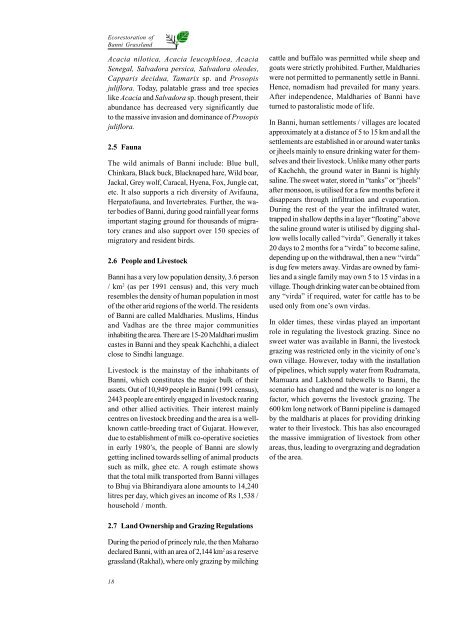Ecorestoration of Banni Grassland - Global Restoration Network
Ecorestoration of Banni Grassland - Global Restoration Network
Ecorestoration of Banni Grassland - Global Restoration Network
Create successful ePaper yourself
Turn your PDF publications into a flip-book with our unique Google optimized e-Paper software.
<strong>Ecorestoration</strong> <strong>of</strong><br />
<strong>Banni</strong> <strong>Grassland</strong><br />
Acacia nilotica, Acacia leucophloea, Acacia<br />
Senegal, Salvadora persica, Salvadora oleodes,<br />
Capparis decidua, Tamarix sp. and Prosopis<br />
juliflora. Today, palatable grass and tree species<br />
like Acacia and Salvadora sp. though present, their<br />
abundance has decreased very significantly due<br />
to the massive invasion and dominance <strong>of</strong> Prosopis<br />
juliflora.<br />
2.5 Fauna<br />
The wild animals <strong>of</strong> <strong>Banni</strong> include: Blue bull,<br />
Chinkara, Black buck, Blacknaped hare, Wild boar,<br />
Jackal, Grey wolf, Caracal, Hyena, Fox, Jungle cat,<br />
etc. It also supports a rich diversity <strong>of</strong> Avifauna,<br />
Herpat<strong>of</strong>auna, and Invertebrates. Further, the water<br />
bodies <strong>of</strong> <strong>Banni</strong>, during good rainfall year forms<br />
important staging ground for thousands <strong>of</strong> migratory<br />
cranes and also support over 150 species <strong>of</strong><br />
migratory and resident birds.<br />
2.6 People and Livestock<br />
<strong>Banni</strong> has a very low population density, 3.6 person<br />
/ km 2 (as per 1991 census) and, this very much<br />
resembles the density <strong>of</strong> human population in most<br />
<strong>of</strong> the other arid regions <strong>of</strong> the world. The residents<br />
<strong>of</strong> <strong>Banni</strong> are called Maldharies. Muslims, Hindus<br />
and Vadhas are the three major communities<br />
inhabiting the area. There are 15-20 Maldhari muslim<br />
castes in <strong>Banni</strong> and they speak Kachchhi, a dialect<br />
close to Sindhi language.<br />
Livestock is the mainstay <strong>of</strong> the inhabitants <strong>of</strong><br />
<strong>Banni</strong>, which constitutes the major bulk <strong>of</strong> their<br />
assets. Out <strong>of</strong> 10,949 people in <strong>Banni</strong> (1991 census),<br />
2443 people are entirely engaged in livestock rearing<br />
and other allied activities. Their interest mainly<br />
centres on livestock breeding and the area is a wellknown<br />
cattle-breeding tract <strong>of</strong> Gujarat. However,<br />
due to establishment <strong>of</strong> milk co-operative societies<br />
in early 1980’s, the people <strong>of</strong> <strong>Banni</strong> are slowly<br />
getting inclined towards selling <strong>of</strong> animal products<br />
such as milk, ghee etc. A rough estimate shows<br />
that the total milk transported from <strong>Banni</strong> villages<br />
to Bhuj via Bhirandiyara alone amounts to 14,240<br />
litres per day, which gives an income <strong>of</strong> Rs 1,538 /<br />
household / month.<br />
2.7 Land Ownership and Grazing Regulations<br />
During the period <strong>of</strong> princely rule, the then Maharao<br />
declared <strong>Banni</strong>, with an area <strong>of</strong> 2,144 km 2 as a reserve<br />
grassland (Rakhal), where only grazing by milching<br />
18<br />
cattle and buffalo was permitted while sheep and<br />
goats were strictly prohibited. Further, Maldharies<br />
were not permitted to permanently settle in <strong>Banni</strong>.<br />
Hence, nomadism had prevailed for many years.<br />
After independence, Maldharies <strong>of</strong> <strong>Banni</strong> have<br />
turned to pastoralistic mode <strong>of</strong> life.<br />
In <strong>Banni</strong>, human settlements / villages are located<br />
approximately at a distance <strong>of</strong> 5 to 15 km and all the<br />
settlements are established in or around water tanks<br />
or jheels mainly to ensure drinking water for themselves<br />
and their livestock. Unlike many other parts<br />
<strong>of</strong> Kachchh, the ground water in <strong>Banni</strong> is highly<br />
saline. The sweet water, stored in “tanks” or “jheels”<br />
after monsoon, is utilised for a few months before it<br />
disappears through infiltration and evaporation.<br />
During the rest <strong>of</strong> the year the infiltrated water,<br />
trapped in shallow depths in a layer “floating” above<br />
the saline ground water is utilised by digging shallow<br />
wells locally called “virda”. Generally it takes<br />
20 days to 2 months for a “virda” to become saline,<br />
depending up on the withdrawal, then a new “virda”<br />
is dug few meters away. Virdas are owned by families<br />
and a single family may own 5 to 15 virdas in a<br />
village. Though drinking water can be obtained from<br />
any “virda” if required, water for cattle has to be<br />
used only from one’s own virdas.<br />
In older times, these virdas played an important<br />
role in regulating the livestock grazing. Since no<br />
sweet water was available in <strong>Banni</strong>, the livestock<br />
grazing was restricted only in the vicinity <strong>of</strong> one’s<br />
own village. However, today with the installation<br />
<strong>of</strong> pipelines, which supply water from Rudramata,<br />
Mamuara and Lakhond tubewells to <strong>Banni</strong>, the<br />
scenario has changed and the water is no longer a<br />
factor, which governs the livestock grazing. The<br />
600 km long network <strong>of</strong> <strong>Banni</strong> pipeline is damaged<br />
by the maldharis at places for providing drinking<br />
water to their livestock. This has also encouraged<br />
the massive immigration <strong>of</strong> livestock from other<br />
areas, thus, leading to overgrazing and degradation<br />
<strong>of</strong> the area.

















